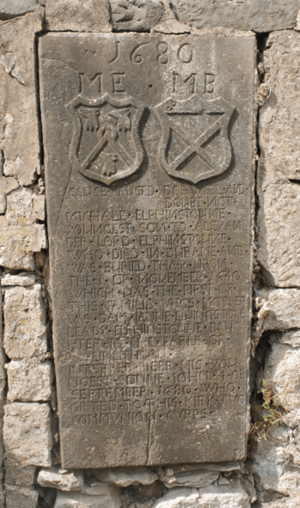Alexander Elphinstone, 4th Lord Elphinstone facts for kids
Alexander Elphinstone, 4th Lord Elphinstone (1552-1638) was an important Scottish nobleman. He owned large areas of land and was a key figure in the royal court of James VI of Scotland. He even served as the Treasurer of Scotland, managing the country's money.
Alexander Elphinstone was the son of Robert Elphinstone, 3rd Lord Elphinstone and Margaret Drummond. His family's lands were mostly south and east of Stirling, near places like Elphinstone and Dunmore. They were close to the Forth and had neighbors like the Drummonds and Bruces. The Elphinstone family also had a long-standing rivalry with the Erskine Earls of Mar.
Until his father passed away in 1602, Alexander was known as "Alexander, Master of Elphinstone." He joined King James VI's court in October 1580, working as a gentleman of the bedchamber. This meant he was a close attendant to the King.
Contents
Life at Court and Important Events
Helping a Prisoner
In May 1585, a woman named Margaret Haldane was held at Kildrummy Castle. Alexander, then the Master of Elphinstone, was in charge of her. An English diplomat asked for her to be moved to a more comfortable place.
After the "Bonny Earl of Murray" Murder
In March 1592, Alexander was involved in the events after the murder of James Stewart, 2nd Earl of Moray, often called the "Bonny Earl of Murray." Alexander was a friend of the Earl of Huntly, who was a prisoner at Blackness Castle. Alexander and some other noblemen went to Linlithgow Palace to see Moray's mother. They offered a large sum of money (100,000 Pounds Scots) to guarantee that Huntly would appear for his trial.
Family Rivalries and Royal Influence
In September 1595, Alexander's family and their allies were in a big disagreement, or "feud," with the Earl of Mar. This was because Mar's servant, David Foster, had been killed. The King even had to forbid the Earl of Mar from going near Alexander's family. The Queen, Anne of Denmark, was thought to encourage Alexander's side against the Earl of Mar. She might have hoped this would weaken Mar's position as the guardian of Prince Henry at Stirling Castle.
Royal Orders and Family Matters
In October 1597, King James VI wrote to Alexander, asking him to hand over a prisoner named Maws Livingstone for her trial.
Alexander had two notable brothers. One, James Elphinstone, 1st Lord Balmerino, was part of a group of royal advisors called the Octavians, who helped manage the country's finances. Another brother, John Elphinstone, worked for Queen Anne of Denmark. He even helped spend some of her dowry (money given at marriage) on clothes and costumes for a big celebration for Prince Henry's baptism in 1594.
Becoming Treasurer of Scotland
Alexander, Master of Elphinstone, was appointed Treasurer of Scotland in 1599. This was a very important job, as he was in charge of the country's money. He held this position until 1601. In July 1600, King James VI ordered him to start repairs on the Palace of Holyroodhouse, a royal residence.
A Son's Troubles
In 1601, Alexander's son, also named Alexander, attended a Catholic church service in Edinburgh. This was against the rules at the time. His son was put in Edinburgh Castle, but his father, who was very upset, arranged for him to be moved to St Andrews to stay with a minister named James Melville. The King later sent a letter of forgiveness to his son.
In 1608, Alexander received a special permission from the King to export coal, which was a valuable trade at the time. Alexander Elphinstone passed away in 1638.
Family Life and Connections
Alexander Elphinstone married Jean Livingston (who died in 1621). She was the daughter of William Livingstone, 6th Lord Livingston. They had several children, including:
- Alexander Elphinstone, 5th Lord Elphinstone (1577-1648): He was known as the "Master of Elphinstone" until his father's death in 1638.
- Agnes Elphinstone (died 1617): She married John Gordon, 13th Earl of Sutherland in a special double wedding on February 5, 1600. Her sister Jean married Arthur, Master of Forbes at the same time. The King and Queen, James VI and Anne of Denmark, were guests at the wedding party, which lasted two days! As gifts, the King gave Agnes and Jean beautiful gold and pearl jewelry. He even lost £82 playing cards during the celebrations!
- Michael Elphinstone of Quarrel and East Skaithmure (1593-1640): He married Mary Bruce.
- Christian Elphinstone: She was set to marry Thomas Urquhart of Cromarty in 1606 and was the mother of the famous writer Thomas Urquhart.
What Was Inside Elphinstone Tower?
After Lord Elphinstone died in 1638, a list was made of all his belongings at his home, the Place of Elphinstone (also known as Elphinstone Tower). His best clothes were there, including "an old silk beaver hat out of fashion." He also had books, such as Great Britain's Solomon and John Smith's The Description of New England.
Other items included a small box with old, unimportant papers, a brass clock for a table, and velvet, damask, and leather cushions. In the tower, there was a wine decanter with seven glasses, a brass warming-pan, and two cabinets with more legal documents. Above the entrance to the inner courtyard, there was an iron clock. All these items were carefully moved to a room upstairs and locked away.
Another document from December 1637 mentions the "New hall of the Place of Elphinstone." It says that Lord Elphinstone sold his fancy velvet robes and saddles to his son. These were used for attending the "riding of the Parliament of Scotland," a formal procession when Parliament met.
See Also
Images for kids
-
Elphinstone Tower near Airth




